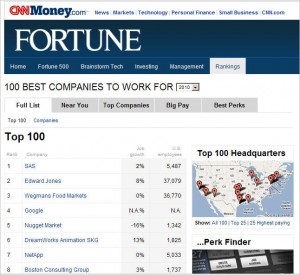More observations on the Fortune 100 Best Companies to Work For list, 2010 . . .
A Lesson from the List: Right-sizing the Corporate Careers Site
Given the fabulous workplace at SAS (see Part 1 for details!), we can surmise that the main challenge for their recruiters really is tracking down those perfect passive candidates and luring top talent through the gates of paradise. Therefore, it’s not surprising that the SAS Careers site is truly minimal—just a (long) list of benefits and some job search tools. That’s all. No videos, testimonials, day in the life, social media. Just the opportunity to apply.
Over at Publix Super Markets, on the other hand, where many prospective employees can expect to work long hours stocking shelves or filling prescriptions, the Careers site has every conceivable bell and whistle. Publix has almost 140,000 employees compared with not quite 6,000 (U.S.) positions at SAS, and as of January 2010 they were looking for 1300 new employees, while SAS was in search of 52.
Point: In considering what is “best practice” for a corporate Careers site, we really need to look at the context. Arguably, SAS doesn’t need a state-of-the-art web presence. Publix does.
A Question about the List: Is It Still Relevant?
A few years ago, the Fortune List seemed to be investigative and informative. It offered examples of what worked in the workplace, and showed off companies that had built solid employer brands. Getting on the list was a valuable achievement, and falling off would presumably be a disgrace.
When you look at that set-up, it becomes obvious that the list is not likely to change much. There are only 100 spots, and once you’ve identified 100 companies that meet the criteria, the quota is full. New places will only open up when a listee messes up seriously, goes out of business, or gets bought up. So by now the news is not who’s on the list, but whether they rise and fall in relative rankings.
This year SAS vaulted from a respectable Twenty all the way to Numero Uno. Why? No way of knowing. Fortune doesn’t explain its rankings. But some suspect that companies figure out the secret of improving their rank and deliberately work their way up. I.e., they study the test.
This year I spotted five newcomers: McCormick, FactSet, Mercedes-Benz, LifeBridge Health Care, and DPR Construction. There are probably more, as I didn’t make an exhaustive comparison—but I’m pretty sure I recognize 90% of the companies as perennials. Given that 353 companies competed . . . the apparent conclusion would be that at least 248 competitors (2/3 of the set) fell short of whatever it would take to dislodge an incumbent.
Point: Maybe it’s time for Fortune to shake up this drill. What about categories for small, medium and large enterprises, to establish a more level playing field? What about special recognitions for innovators and most improved companies? What about breaking out the citations for listees in terms of (a) tangibles like pay and perks, and (b) intangibles like respect, fun, loyalty, etc. And what about adding a new point of view, so the Great Place to Work Institute is not the sole arbiter?
Just some thoughts . . .
Lucy is Editor at Corporate Eye
